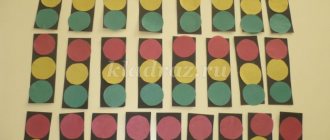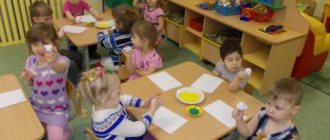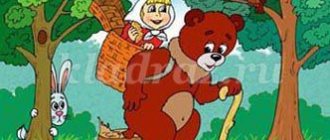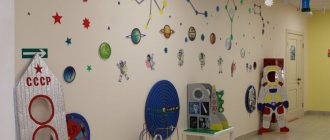Summary of a lesson on health conservation in the junior group Topic: Travel to the country “Neboleyka”
Summary of a lesson on health conservation in the younger group
Topic: Travel to the country "Neboleyka"
Target
:
developing children's ideas about a healthy lifestyle.
Tasks:
To consolidate children's knowledge of the concept of health, the ability to take care of their health. Reinforce the concept of “proper nutrition.”
Cultivate an interest in physical exercise and self-massage.
Equipment:
“Moidodyr’s bag” with personal hygiene items (soap, comb, handkerchief, mirror, toothpaste, toothbrush, towel), a set of illustrations – “Food”, pictures about a healthy lifestyle; phonogram: “Charging”.
Progress of the lesson:
Educator:
Today we have gathered with you to talk about health. What word is the word “health” similar to? That's right, the word health is similar to the word “hello.” When we say hello, we wish each other health. Let's say hello to each other and do it in the game.
game “Hello, friend! »
Hello Friend! (Children extend their right hand to the side)
Hello Friend! (Stretch left arm to the side)
Get in a circle quickly, (Hold hands)
We'll go in circles (Go in circles)
And we will find friends everywhere!
Educator
: Guys, what is health? (children's answers)
Health is strength, beauty, when the mood is good and everything works out.
Educator
: Do you want to be healthy? (children’s answers)
Educator:
Guys, do you like to travel? How can you go on a trip?
Children:
Car, train, bus...
Educator:
I invite you today to go on a trip to the country of Neboleyka.
We'll go there by train. Do you agree? Take your seats in the trailers! (we move around the group).
Educator
: Guys, we have arrived in the country of Neboleyka.
(There are supporting pictures about a healthy lifestyle on the board)
Educator:
Who do you think lives in Neboleyka?
Children: people live here who are not sick.
Educator
: What should you do to avoid getting sick and be healthy?
Children:
you need to exercise, do exercises, walk, eat right, and keep things clean.
Educator
: Right!
Guys, let's do some exercises. At first I’ll be small, I’ll snuggle up to my knees. Then I will grow big and reach the lamp. (Children squat down with their heads bowed and clasp their knees with their hands, then gradually straighten up, stand on their toes and stretch upward as much as possible, raising their arms.)
Every day Every day in the morning We do exercises.
(Walking in place.)
We really like to do it in order: Walk happily,
(Walk.)
Raise your arms, (
Hands up.)
Squat and stand,
(Squat 4-6 times.)
Jump and gallop.
(10 jumps.)
Teacher
: There is another very simple way to improve your health - self-massage. This is stroking, rubbing, pressing. A person does this massage to himself.
Self-massage
Nose, nose! (touch the tip of the nose with your index finger)
. Where have you been?
Mouth, mouth! (Run your index finger (two hands) from the corner of your lips up and down)
. Where are you little mouth?
Cheek, cheek! (we stroke the cheeks with circular movements (two hands))
.Where are you, cheek?
There will be a clean daughter. (circular movements clockwise along the oval of the face)
Educator:
Friends, I’ll tell you a secret that many foods are tasty, but they don’t contain any vitamins, which means they don’t bring any benefit.
Let's figure out which foods are harmful to us and which are healthy.
Didactic game “Helpful - Harmful”
I suggest you grow miracle trees that will grow healthy and harmful foods. Here are pictures depicting various food products (vegetables, candies, fruits, chips, milk, a carbonated drink in a bottle, fish, ice cream, eggs, brown bread, etc.). Each of you will come up, take one card with a picture of a useful product and hang it on the tree. (The teacher explains why you should not eat chips and other junk food, why you should eat sweets in moderation).
Educator:
Look what this one is? Pouch. And in the bag there are items that help us take care of our health. Let's play.
Didactic game "Moidodyr's Bag"
Children guess personal hygiene items (soap, comb, handkerchief, towel, mirror, toothpaste and brush, clothes brush) by touch and tell what they are for and how to use them.
Well, it’s time for us to return home to the d/s. We sit in our comfortable trailers.
Educator:
- Let's remember where we were???
Children: - In the country "Neboleyka"
Educator:
- What kind of country is this? Why is it called that?
Children
: — No one gets sick there and takes care of their health. To find your health and not lose it, you need to eat well, walk in the fresh air, do exercises every day and remember to wash your hands.
Educator:
Residents of the country “Neboleyka” have compiled some useful tips for you:
- To grow and harden
We need to play sports.
- May you not be too lazy
Brush your teeth 2 times a day.
- Fruits and vegetables before meals
Carefully, very carefully mine.
- Go to bed on time, get up on time
Follow your daily routine.
- Here's another simple tip
Wash your hands before eating.
- Handkerchief and comb must be yours
Remember this and don’t use other people’s.
Educator.
Guys! Today you have learned a lot of useful things about health and I see a smile on your faces, and a smile is the key to a good mood. This is how we give each other health and joy! Good health to you!
Lesson in the second junior group “Journey to the land of health”
Bibliographic description:
Folmer, G. N. Lesson in the second junior group “Journey to the Land of Health” / G. N. Folmer, N. Yu. Kireeva. — Text: direct // Questions of preschool pedagogy. - 2022. - No. 8 (25). — P. 88-90. — URL: https://moluch.ru/th/1/archive/140/4485/ (access date: 01/18/2022).
Goal: to form initial ideas about a healthy lifestyle.
Tasks:
- Educational field “Physical education”: develop children’s motor activity; develop the ability to build one at a time; development of the ability to move rhythmically; development of movement coordination.
- Educational area “Health”: Expand and enrich children’s ideas about a healthy lifestyle: talk about the benefits of vitamins, make children want to eat as many vegetables as possible, show their importance in maintaining people’s health, give children an understanding of group A vitamins ", "B", "C".
- Educational area “Socialization”: cultivate a respectful attitude towards each other, show emotional responsiveness to a game situation with a ball.
- Educational area “Cognition”: develop cognitive-emotional interest, teach how to greet politely.
- Educational area “Communication”: learn to answer the teacher’s questions in short sentences; continue to teach children to pronounce words and phrases with natural intonation, enrich children’s vocabulary: hello, vitamins.
- Educational area “Artistic creativity”: continue to introduce the properties of plastic materials, learn to tear off pieces from a large piece and sculpt balls.
Materials and equipment: vitamins, dough, plates for molded vitamins, a balloon with the inscription “Hello”, pictures with images of the inhabitants of the country “Healthy People”, presentation “Vitamins”, a hare costume, modules for the “Healthy People” house.
Methods and techniques: conversation, breathing exercises, communicative game “Hello”, surprise moment, didactic game “Who is the odd one out for the country of big guys”
Preliminary work: conducting individual and group conversations with children and parents, reading the books “Moidodyr” by K. Chukovsky, “What is good and what is bad” by S. Marshak, “The Dirty Girl” by A. Barto, looking at illustrations.
V.: Guys. What is this? (Ball) Look how he smiles. Let's listen to what Sharik has to say.
Sharik: I have a lot of work.
They call me all day long.
You will only meet someone you know -
I'm right here again.
To wish you health
You need to say “Hello”.
V.: Sharik greets us, it says hello here. Let's say hello to him too.
A communicative game “Hello!” is being held.
Hello, palms! Clap-clap-clap! (clap hands)
Hello legs! Top-top-top! (stomp feet 3 times)
Hello, Cheeks! Plop-plop-plop! (lightly slap the cheeks 3 times)
Chubby cheeks! Plop-plop-plop! (circular movements on the cheeks)
Hello sponges! Smack-smack-smack! (smack lips 3 times)
Hello, teeth! Click-click-click! (click teeth 3 times)
Hello my nose! Beep-beep-beep! (press the nose 3 times with the index finger)
Hello, Sharik! (stretch their arms forward, palms up).
V.: In the word “Hello” there are sounds “z”, “d”, “r”, which give us a charge of vivacity. When we say “Hello,” it means we wish each other health and immediately feel better and our mood lifts.
Q: How do you understand what it means to be healthy? (Children's answers: A healthy person does not get sick. A healthy person is strong, grows quickly. A healthy person plays sports, does exercises. A healthy person is in a good mood).
V.: That's right.
Sharik told me that the secrets of health live in the amazing country of Healthy People. Let's go there on the health train (the steam locomotive appears).
Chug-chug-puff, chug-chug-drive,
I don't want to stand still!
(Breathing exercises: inhale through the nose, while exhaling we say “chuh-chuh”).
The locomotive is moving, moving,
Two pipes and a hundred wheels.
(Breathing exercises: inhale through the nose, while exhaling we say “chuh-chuh”).
We work with our feet deftly,
We drove, we drove... stop, stop!
(Breathing exercises: inhale through the nose, while exhaling we say “chuh-chuh”).
The children follow each other. (Breathing exercises: inhale through the nose, while exhaling we say “chuh-chuh”).
V.: Here we are. What a big house in the country of the Big Guys. Let's see who lives in it?
Didactic game “Who is the odd one out for the country of the Big Guys.” Pictures of smiling people doing creative work and sports. Pictures of sad, angry, lazy, sick people.
Now we are going to play the game “Who is the odd one out for the country of Big Guys”, come to the tables.
Among the pictures, select images of the inhabitants of the country “Healthy People”.
Children choose pictures depicting healthy people.
What kind of people are they like in the country of health? (beautiful, cheerful, smiling, joyful, cheerful, slim, healthy).
Why wasn't this boy chosen? (he is sick, sad).
Children attach pictures to the house.
Q: So we found out the secret of the Big Guys and which emoticon will you choose? (choose 2 emoticons: sad and happy) (hang the secret of health on the house: say hello and smile)
Getting to know new material. Sad music is playing. A hare appears.
Z.: My bunnies began to get sick often. When fresh vegetables and fruits run out, the bunnies become weak. Why?
V.: They lack vitamins.
Z.: What are vitamins? Introduce me to them.
V.: Vitamins are very useful. It gives strength, makes everyone agile, cheerful, and helps them grow faster. Sit down, watch and listen carefully.
(B. Displays an image of vitamin “A” on the monitor)
“I, vitamin A.” They also call me orange vitamin because I live in carrots. If you don't eat me, your eyes will see worse. Don't forget about it! "
"I, vitamin B." I live in black bread, in oatmeal and in sorrel and help my heart work well (dry how your heart beats) It works, it beats well, because you ate porridge in kindergarten today.
“And they call me the green vitamin, my real name is vitamin C.” I live in currants, onions, rose hips, sauerkraut, lemon, orange. I strengthen the entire body, making you healthier. Eat these foods more often, and then we will be friends forever.
Q: Children, what foods did vitamin C advise us to eat? Let's name them again (Children list).
(Multimedia images of all three vitamins)
Q: Where do vitamins live? (Children's answers) V.: That's right, in vegetables, fruits, healthy foods: porridge, bread... there are substances important for health, which are called vitamins. There are a lot of them, but the main ones are A.B.S.
Q: And if you run out of vegetables and fruits, you need to drink vitamins, which are sold at the pharmacy in boxes or bottles. These are small multi-colored balls, sweet and sour, and taste like candy. But you can’t eat too many of them, take one vitamin a day and only when your mother or one of the adults gives it.
Z.: Give me these vitamins for rabbits.
V-l takes the jar, it’s empty - Oh, the jar is empty!
V.: Let's, guys, help the bunnies and their mother. There is no pharmacy in the forest, so we make our own vitamins (The teacher gives the vitamins on a plate)
Q: Consider a vitamin supplement. What color is it?
V.: Now take it in your hands and roll it around. What is its shape? (round)
V.: Today we are working with dough. We will take small lumps from a large lump and use circular movements of our palms to give them a rounded shape and place them on a plate (we work)
The hare thanks the children for the fashioned vitamins and offers to put them in a jar. She will take them to her bunnies.
Q: Guys, why do healthy people live in the country of Healthy People?
Children: because they say hello and wish you health. They are smiling. They are in a good mood. They eat healthy foods that contain vitamins A.B.C.
V.: And now we need to return to the group.
Once, twice, three times we smiled,
We turned around ourselves,
We jump-jump, jump-jump over the bumps.
We crossed the bridge. We came back to the group.
Key terms
(automatically generated)
: educational area, vitamin, breathing exercises, healthy person, child, ball, didactic game, healthy lifestyle, communicative game, good mood.






